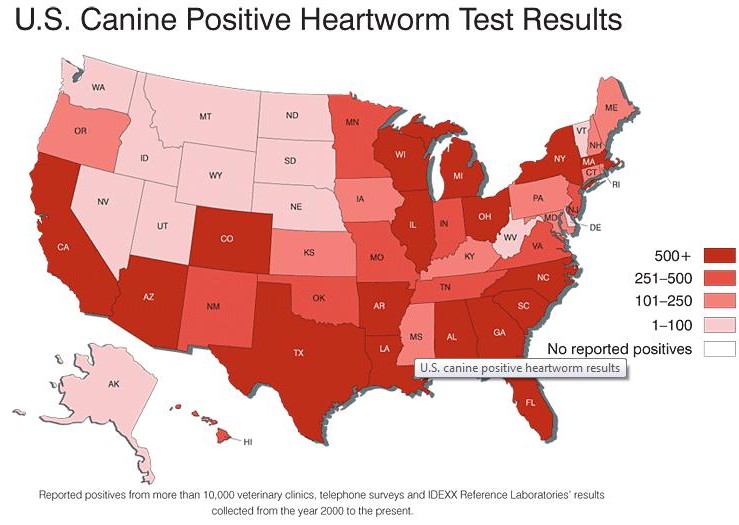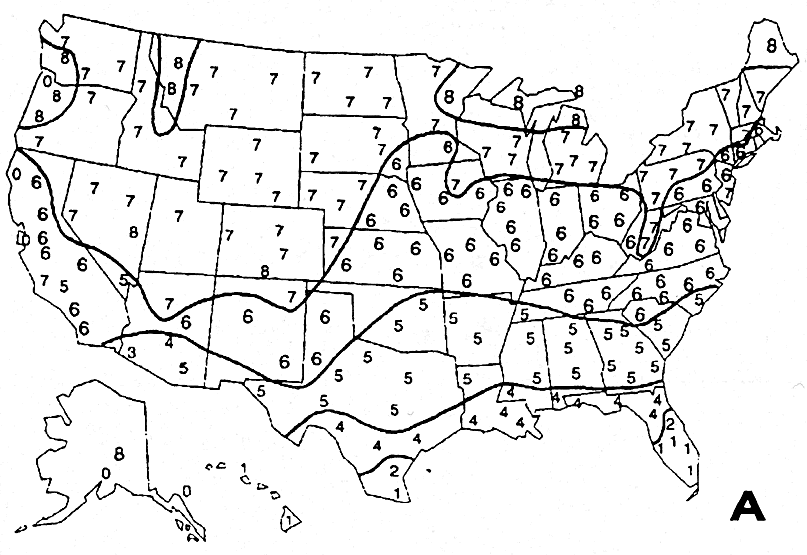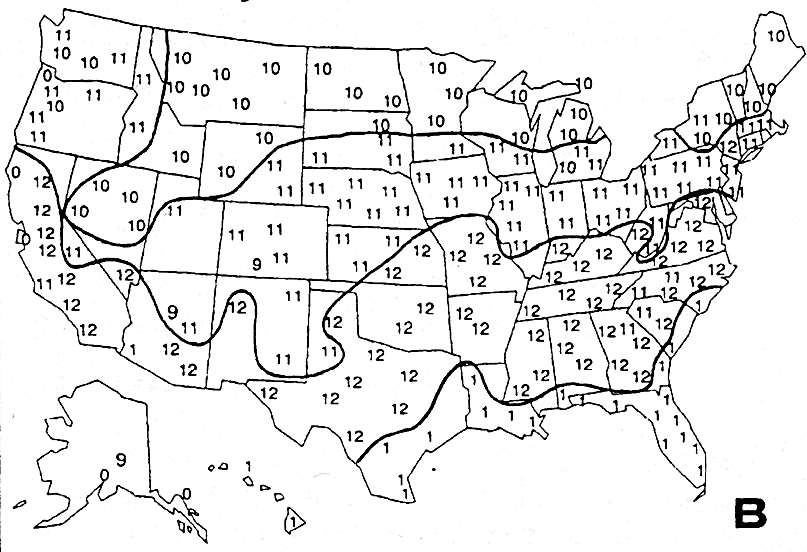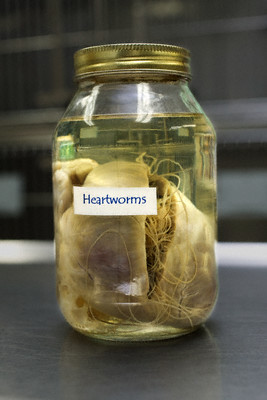|
|
Billion Dollar Heartworm ScamAlmost everything you have been told and taught about heartworm is probably an exaggeration or an outright lie, and this misinformation is probably costing you real money. Here is the Truth: 1. Heartworm is not a canine pandemic.In fact, heartworm is pretty rare in much of the country, and in very cold areas of the country a veterinarian may go his or her entire career without seeing a single case. Look at the map, above, put out by a major vendor of heartworm tests (Idexx) who has every reason in the world to overstate (rather than to understate) the problem. You will notice how low the baseline state numbers are -- 500 cases is the top of the color scale -- and that this map covers seven years of data collecting. You will also note that this map does not show adult heartworm infestation in dogs, but simply the number of dogs that tested positive for heartworm. More on that important distinction in a minute. Data on heartworm incidence rates at the local level reinforces how rare heart worm really is. For example, on the map above, California is coded red-hot with 500 cases. And yet, when a total of 4,350 dogs in 103 Los Angeles County cities coming from 21 participating animal hospitals were tested, only 18 heartworm-positive tests turned up. And yet, veterinarians are training their staffs not to talk about heartworm tests and medications as an option, but as a need, and for this "needs to be given" message to be bombarded on the customer 3-5 times per office visit. 2. Heartworm infection is NOT rapid and will not kill your dog overnight.It takes about three months for microfilaria (baby worms) to grow inside your dog to a larval stage, and even longer for these larva to mature into adult heartworms. If your dog is dosed with a simple Ivermectin treatment at any time during this period before adult worms are present (a period that lasts about three months long), the larvae will never develop into adult worms, and will die. Read that statement again: a single dose of Ivermectin will stop heartworm dead up to 3 months after your dog is first infected. 3. In most of the country, only seasonal heatworm "prevention" is needed.The short story here is that heartworm is a kind of nematode (dirofilaria immitis) spread by mosquitoes (and only by mosquitoes). The lifecycle of the nematode involves six stages, and a dog can get infected with heartworm only if two of these stages are fully completed inside the body of the mosquito, and those stages can only be completed inside the body of the mosquito if the temperature stays above 57 degrees for at least 45 days straight, both day and night. If the temperature drops below 57 degrees even once during that 45-day period, the lifecycle of the nematode is broken, and heartworm cannot be transmitted to your dog. What this means, in simple terms, is that a year-round program of Heartgard (sometimes spelled 'Heartguard") or some other "preventative" medicine is NOT needed in most of the country outside of Florida, the Rio Grande Valley of Texas. Look carefully at the maps below (click to enlarge). These maps come from "Seasonal Timing of Heartworm Chemoprophylaxis in the United States" by Dr. David Knight and James Lok of the American Heartworm Society. Find your area on the map, and begin heartworm treatment on the first day of the month noted in Map A, and end treatment on the first day of the month noted in Map B. In short, if you are living in Virginia, you would begin treating your dog June 1st (top map) and end treatment on December 1st (bottom map).  Maps created by DH Knight and JB Lok  Maps created by DH Knight and JB Lok 4. There is no "preventive" medicine for Heartworm.Despite what your veterinarian may have told you, there is NO "prevention" for heartworm infection; there is only heartworm treatment. ALL heartworm medicines work the same way -- they kill heartworm microfilaria present in the body of the dog. 5. Heartworm "prevention" medicines are actually toxic poisons.The drugs used to kill heartworm microfilaria are Ivermectin (Heartgard, Heartgard Plus, Iverhart, Merial and Verbac) or Milbemycin (Interceptor, Safeheart, Sentinal and Norvartis). Both drugs are nematode poisons, and in both cases a single dose will kill all microfilarial infection that occurred up to 90 days earlier (i.e. all Stage 3, 4 and young Stage 5 heartworm infections). 6. Humans cannot get heartworm.Heartworm cannot be passed on to humans -- we are the wrong host animal. Very rarely a heartworm-positive mosquito will bite a human and a small benign cyst may develop in the lung of a human, but this is NOT heartworm, and can be best thought of as a tiny scar showing where a bit of microfilaria attached to the lung wall where it was killed off by the human body. 7. Some breeds of dogs should not be treated with Ivermectin.Some lines of collies and collie-crosses have strong -- sometimes fatal -- reactions to ivermectin, the most common heartworm preventative medicine. Though this is not common, and seems to only hold true for collies, serious thought needed to be given to dosing any collie, collie-cross, or herding dog with white feet Ivermectin. For these dogs, the safest heartworm medicine is Interceptor. 8. What about that wormy heart-in-a-jar at my vets office?
9. Do I have to go a veterinarian to get Ivermectin?No. More on that in a second. Suffice it to say that it's not necessarily a bad thing to go to a vet for a prescription for Heartgard, especially if you are going to see your vet on another matter anyway. I would not buy Heartgard from the vet, however, without first checking prices online. Most vets price-gouge their customers by 100 percent or more for medicines sold in their offices, and in most states a veterinarian cannot charge you more for writing a prescription for a medically necessary medicine as part of an incidental visit. Another cash-saving tip is to get a prescription for Heartgard for a dog twice the size of your dog, and then split the tablets in half. This trick results in considerable savings because the marginal cost between one Heartgard weight category and the next is often very slight despite the fact that one pill contains twice as much active ingredient as the next. Finally, remember that you do not have to dose your dog all year long or even every month. In fact, if you have a 50-pound dog, and buy 12 doses of Heartgard for a 100-pound dog, you could be 100-percent covered for six years, even in a year-round heartworm area, provided you dosed your dog once every three months and cut the pills in half. Of course, if you want to dose your dog every month and do so cheaply and without going to a veterinarian for a prescription, there's a trick here too. Here it is: Order your Ivermectin in a pre-mixed solution. The cost is $25 for a 65-cc bottle of .05% Ivermectin, which is enough to treat five 20-pound dogs for 26 months. J.R. Enterprises even throws in a measuring spoon! Since this Ivomec and polypropelene gylcol solution is not FDA-approved for dogs, they sell it for experimental purposes only. That said, it works fine, and this is exactly the kind of heartworm preventative medicine used on all dogs all across this country prior to the advent of Heartgard and "the billion-dollar heartworm scam" in 1986. Finally, and if for no other reason that to explain how to make it, here's how you can treat a huge number of dogs with non-prescription Ivermectin for a dirt-cheap price. Whether this is cost-effective or not (and whether it is worth the trouble or not) really depends on how many dogs you have. In case you run a shelter, here's the recipie:
10. Do I need to have my dog tested for heartworm before starting Ivermectin?Generally, no. Unless your dog is an older dog loaded with years of untreated heartworm (which you will know from the dog's long-term lethargy and chronic coughing), a dose of Ivermectin will not do your dog harm. A puppy, under six months of age, of course, will always test negative for heartworm because the microfilaria have not yet had a chance to develop and circulate. Testing a dog under age 6 months for heartworm is a common veterinary scam; do not fall for it! 11. Is curing heartworm expensive and difficult?No it is not. Any veterinarian who tells you otherwise is not keeping up with the literature. It turns out that even if your dog has adult heartworms, if the dog otherwise appears healthy (i.e. it is active, not lethargic, and does not have a chronic cough), a monthly dosing of Ivermectin at a dosage normally used to kill roundworms (a dosage that is 3 times higher than that used to simply prevent heartworm), plus a once-a-month 5-day dosing of Doxycycline (the same antibiotic used to treat Lyme disease) will kill all the adult heartworms if it is sustained for a period of 18 months. This treatment works better than previous Ivermectin-only treatments because the Doxycline wipes out the Wolbachia microbe that grow in the gut of the adult heartworm, essentially sterilizing all of the female heartworms. A round-worm strength dosing of monthly Ivermectin will not only prevent new heartworm microfilaria from taking hold in your dog, it will also work to dramatically shorten the life of any existing adult worms in your dog. Bottom line: after 18 months of treatment, your dog will be heartworm-free at very little cost compared to other remedies. A repeated caution, however: if you have border collies or herding dogs with white feet that also appear to have full-blown heartworm, consult a veterinarian, as some lines of collies are very susceptible to Ivermectin toxicity. This is very rare, and the cause is unknown, but it is an area of concern among collies and collie-crosses. A simple rule of thumb: if you dog can take HeartGuard without issues, and the main active ingredient is Ivermectin, then you will have no negative issues using Ivermectin in liquid form. It is the exact same amount of the active ingredient Ivermectin. |
|
|
|
© 2010-2016 Shiba-Puppies.com • All Rights Reserved • www.Shiba-Puppies.com Fair Use Notice: This site may contain copyrighted material whose use has not been specifically authorized by the copyright owners. We believe that this not-for-profit, educational use on the Web constitutes a fair use of the copyrighted material (as provided for in section 107 of the US Copyright Law). If you wish to use this copyrighted material for purposes of your own that go beyond fair use, you must obtain permission from the copyright owner. |

















 Most veterinarians have a "fear bottle" in their office which shows a canine heart riddled with spaghetti-like
heartworms. Nothing generates cash like a heartworm fear bottle -- a veterinarian will often place one prominently
in his or her office as a kind of cash-generating machine since one look will sell a heartworm test and
year's worth of Heartgard, no questions asked. So where do these fear bottles come from? I've been told by a
pharmaceutical sales representative that most of these wormy hearts in these jars come from stray animals killed
in Mexico, and that the heart specimens themselves (often decades old) were given out by pharmaceutical company
representatives when they first began selling Heartgard back in 1986. One thing for sure: today, you can got to
Maine and find a wormy heart in a jar even though the local veterinarian has never even seen a dog with this
problem in the last 20 years.
Most veterinarians have a "fear bottle" in their office which shows a canine heart riddled with spaghetti-like
heartworms. Nothing generates cash like a heartworm fear bottle -- a veterinarian will often place one prominently
in his or her office as a kind of cash-generating machine since one look will sell a heartworm test and
year's worth of Heartgard, no questions asked. So where do these fear bottles come from? I've been told by a
pharmaceutical sales representative that most of these wormy hearts in these jars come from stray animals killed
in Mexico, and that the heart specimens themselves (often decades old) were given out by pharmaceutical company
representatives when they first began selling Heartgard back in 1986. One thing for sure: today, you can got to
Maine and find a wormy heart in a jar even though the local veterinarian has never even seen a dog with this
problem in the last 20 years.